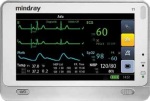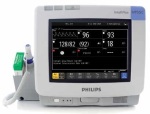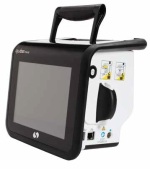Patient Monitors – Fighting alarm fatigue, EMR integration and going wireless
May 22, 2017
by Lisa Chamoff, Contributing Reporter
The beeps and alarms emitted by patient monitors make up the background noise at every hospital.
The trend in the market, however, is an effort to reduce those sounds, weeding out the false alerts and helping facilities get out from under the crushing avalanche of alarm fatigue.
Companies are also integrating their patient monitoring products with hospital EMRs, going wireless and inching forward to the next frontier — in-home monitoring, in an effort to decrease readmission rates.
Here’s what’s new from several of the top patient monitor manufacturers.
EarlySense
EarlySense manufactures a contact-free patient monitor and analytics platform, with a sensor that goes under the mattress and provides continuous vital sign and motion information.
“With the contactless sensor, there is no issue with the sensor falling off,” says Avner Halperin, EarlySense’s chief executive officer.
At the end of 2016, the company launched the InSight, a lighter version of its Early-Sense system without a monitor at the bedside.
“That’s valuable in a post-acute setting where you don’t necessarily want a hospital-like feeling,” Halperin says. “It’s lighter and easier to install because there’s nothing at the bedside. Alerts are much more valuable at the central station and on a mobile device.”
The system also reports on alert response times and has advanced algorithms for reducing false alarms.
“With our system, you can tailor who gets certain alerts,” Halperin says. “A nurse can get alerts for certain patients. If the nurse doesn’t respond, alerts can automatically be escalated to someone else.”
The company also recently introduced the product EarlySense LIVE for the home, which provides full cardiac and respiratory sensing as well as sleep analysis. While the product is only available for the consumer market, Halperin notes that in the future, hospitals will deploy similar technology to reduce readmission rates.
“There’s no question that that’s where we’re going,” Halperin says. “That’s where the future is.”
GE Healthcare
At HIMSS in 2016, GE Healthcare launched Alarm Spotlight, an analytics application that allows clinicians to tailor the threshold for alarms, visualizing alarm burden by day and by type of alarm, with the goal of reducing alarm fatigue.
“Seventy percent of alarms in the ICU are false positives,” says Ajay Parkhe, the general manager of GE’s monitoring solutions business.
For example, if an alarm is set when a pulse oximeter measures the saturation of peripheral oxygen (SpO2) at 91 percent, a facility could use the data generated by the application and set an alarm to sound when the SpO2 level goes down to 89 percent, Parkhe says.
Earlier this year, the company also launched a new version of its CARESCAPE Central Station product.
GE also recently announced the acquisition of Monica Healthcare, a monitoring technology company based in the U.K. that manufactures the Novii, a wireless patch that monitors maternal heart rate, fetal heart rate and uterine activity during labor, allowing women to move more freely.
Infinium Medical
Infinium Medical released its CLEO vital signs/CO2 monitor, a basic model that tracks blood pressure, CO2 and temperature, in the U.S. last year.
The company markets to clinicians who are price conscious, such as sedation dentists and oral surgeons, says Suleyman Bilgutay, managing partner at Infinium Medical.
“With the CLEO, we wanted the most cost-effective CO2 measurement on the market,” Bilgutay says.
The product costs 30 percent less than the company’s competing products, which retail for $2,500 to $3,500, he said.
Mindray North America
In the last 15 months, Mindray North America had several new releases.
The first was the T1 Transport Monitor/Module, part of Mindray’s Passport family of monitors. The T1 can function as a transport monitor, a multi-parameter monitor module and a traditional bedside monitor when connected to an external 19-inch touch-screen display.
“In the emergency department, the T1 can be used to monitor overflow patients when a room or pod is not available,” says Jeff Corliss, senior director of marketing for Mindray North America. “When the room is available, the T1 can convert to a bedside monitor with large display. When the patient moves from the ED to an inpatient environment, the T1 serves as a module plugged into the more comprehensive Passport monitor.”
The company also introduced BeneVision Central Station, which allows clinicians to remotely monitor patients across the hospital, and the BeneVision TD60 Display Telemetry/Transmitter. The TD60 is a compact telemetry unit with large display that is gesture-driven like an iPhone, that allows the patient to be monitored while ambulating, Corliss says.
Mindray has also expanded its medical record integration capability with the eGateway integration engine, which allows patient monitoring data to be transferred to the hospital’s EMR.
Philips
Like other companies, Philips is focused on helping hospitals achieve better patient outcomes and reducing costs. To that end, last fall Philips released its next generation IntelliVue Guardian Solution with early warning scoring that Felix Baader, the company’s business leader for patient monitoring, says uses artificial intelligence to provide early detection of patient deterioration.
Nurses in the low-acuity space monitoring vital signs will be alerted and can prevent adverse events, Baader says.
“Based on these vital signs being fed into it, we can do the really early deterioration protection,” Baader says.
In March 2016, at HIMSS in Las Vegas, Philips also launched its IntelliSpace Console Critical Care, which provides a cloud-based clinical decision support dashboard in the ICU. It combines information such as vital signs, lab data and medication information and provides an overview, with all the essential information for ICU physicians to make patient care decisions.
“This is the glue integrating our hardware and our services together,” Baader says. “These solutions offer the real value to the customer and the patient, be it providing more reliable information used for discharging the patient from the ICU to the general ward, reducing readmissions and reducing cardiac arrest.”
Spacelabs Healthcare
In 1969, technology from the aptly-named company was used to monitor the vital signs of astronaut Neil Armstrong during his walk on the moon. Today, Spacelabs is working on the modern-day health care challenges associated with patient monitoring, including alarm fatigue, monitoring patients during transport and early ambulation.
Less than a year ago, the company introduced SafeNSound, which battles alarm fatigue by allowing clinicians to review a customized alarm summary, including statistics for each monitored patient, to help in determining appropriate alarm protocols.
In May, the company will release its high-acuity Qube Mini monitor, for monitoring during patient transport. The Qube Mini will have an eight-inch screen and an integrated IV pole mount, which the company says allows clinicians to easily monitor what’s happening with their patient throughout the trip.
All Spacelabs monitors are capable of utilizing the wireless accessory at an additional cost, which Robert Hoctor, vice president of global strategic marketing for Spacelabs, says allows patients to move around while their heart activity continues to be monitored.
“This patient area network eliminates the need for a traditional telemetry network and the costs associated with this type of deployment,” Hoctor says. “The result is maximum flexibility to exercise patients with reduced risk of tripping hazards and clumsy equipment management.”
The trend in the market, however, is an effort to reduce those sounds, weeding out the false alerts and helping facilities get out from under the crushing avalanche of alarm fatigue.
Companies are also integrating their patient monitoring products with hospital EMRs, going wireless and inching forward to the next frontier — in-home monitoring, in an effort to decrease readmission rates.
Here’s what’s new from several of the top patient monitor manufacturers.
EarlySense
EarlySense manufactures a contact-free patient monitor and analytics platform, with a sensor that goes under the mattress and provides continuous vital sign and motion information.
“With the contactless sensor, there is no issue with the sensor falling off,” says Avner Halperin, EarlySense’s chief executive officer.
At the end of 2016, the company launched the InSight, a lighter version of its Early-Sense system without a monitor at the bedside.
“That’s valuable in a post-acute setting where you don’t necessarily want a hospital-like feeling,” Halperin says. “It’s lighter and easier to install because there’s nothing at the bedside. Alerts are much more valuable at the central station and on a mobile device.”
The system also reports on alert response times and has advanced algorithms for reducing false alarms.
“With our system, you can tailor who gets certain alerts,” Halperin says. “A nurse can get alerts for certain patients. If the nurse doesn’t respond, alerts can automatically be escalated to someone else.”
The company also recently introduced the product EarlySense LIVE for the home, which provides full cardiac and respiratory sensing as well as sleep analysis. While the product is only available for the consumer market, Halperin notes that in the future, hospitals will deploy similar technology to reduce readmission rates.
“There’s no question that that’s where we’re going,” Halperin says. “That’s where the future is.”
GE Healthcare
At HIMSS in 2016, GE Healthcare launched Alarm Spotlight, an analytics application that allows clinicians to tailor the threshold for alarms, visualizing alarm burden by day and by type of alarm, with the goal of reducing alarm fatigue.
“Seventy percent of alarms in the ICU are false positives,” says Ajay Parkhe, the general manager of GE’s monitoring solutions business.
For example, if an alarm is set when a pulse oximeter measures the saturation of peripheral oxygen (SpO2) at 91 percent, a facility could use the data generated by the application and set an alarm to sound when the SpO2 level goes down to 89 percent, Parkhe says.
Earlier this year, the company also launched a new version of its CARESCAPE Central Station product.
GE also recently announced the acquisition of Monica Healthcare, a monitoring technology company based in the U.K. that manufactures the Novii, a wireless patch that monitors maternal heart rate, fetal heart rate and uterine activity during labor, allowing women to move more freely.
Infinium Medical
Infinium Medical released its CLEO vital signs/CO2 monitor, a basic model that tracks blood pressure, CO2 and temperature, in the U.S. last year.
The company markets to clinicians who are price conscious, such as sedation dentists and oral surgeons, says Suleyman Bilgutay, managing partner at Infinium Medical.
“With the CLEO, we wanted the most cost-effective CO2 measurement on the market,” Bilgutay says.
The product costs 30 percent less than the company’s competing products, which retail for $2,500 to $3,500, he said.
Mindray North America
In the last 15 months, Mindray North America had several new releases.
The first was the T1 Transport Monitor/Module, part of Mindray’s Passport family of monitors. The T1 can function as a transport monitor, a multi-parameter monitor module and a traditional bedside monitor when connected to an external 19-inch touch-screen display.
“In the emergency department, the T1 can be used to monitor overflow patients when a room or pod is not available,” says Jeff Corliss, senior director of marketing for Mindray North America. “When the room is available, the T1 can convert to a bedside monitor with large display. When the patient moves from the ED to an inpatient environment, the T1 serves as a module plugged into the more comprehensive Passport monitor.”
The company also introduced BeneVision Central Station, which allows clinicians to remotely monitor patients across the hospital, and the BeneVision TD60 Display Telemetry/Transmitter. The TD60 is a compact telemetry unit with large display that is gesture-driven like an iPhone, that allows the patient to be monitored while ambulating, Corliss says.
Mindray has also expanded its medical record integration capability with the eGateway integration engine, which allows patient monitoring data to be transferred to the hospital’s EMR.
Philips
Like other companies, Philips is focused on helping hospitals achieve better patient outcomes and reducing costs. To that end, last fall Philips released its next generation IntelliVue Guardian Solution with early warning scoring that Felix Baader, the company’s business leader for patient monitoring, says uses artificial intelligence to provide early detection of patient deterioration.
Nurses in the low-acuity space monitoring vital signs will be alerted and can prevent adverse events, Baader says.
“Based on these vital signs being fed into it, we can do the really early deterioration protection,” Baader says.
In March 2016, at HIMSS in Las Vegas, Philips also launched its IntelliSpace Console Critical Care, which provides a cloud-based clinical decision support dashboard in the ICU. It combines information such as vital signs, lab data and medication information and provides an overview, with all the essential information for ICU physicians to make patient care decisions.
“This is the glue integrating our hardware and our services together,” Baader says. “These solutions offer the real value to the customer and the patient, be it providing more reliable information used for discharging the patient from the ICU to the general ward, reducing readmissions and reducing cardiac arrest.”
Spacelabs Healthcare
In 1969, technology from the aptly-named company was used to monitor the vital signs of astronaut Neil Armstrong during his walk on the moon. Today, Spacelabs is working on the modern-day health care challenges associated with patient monitoring, including alarm fatigue, monitoring patients during transport and early ambulation.
Less than a year ago, the company introduced SafeNSound, which battles alarm fatigue by allowing clinicians to review a customized alarm summary, including statistics for each monitored patient, to help in determining appropriate alarm protocols.
In May, the company will release its high-acuity Qube Mini monitor, for monitoring during patient transport. The Qube Mini will have an eight-inch screen and an integrated IV pole mount, which the company says allows clinicians to easily monitor what’s happening with their patient throughout the trip.
All Spacelabs monitors are capable of utilizing the wireless accessory at an additional cost, which Robert Hoctor, vice president of global strategic marketing for Spacelabs, says allows patients to move around while their heart activity continues to be monitored.
“This patient area network eliminates the need for a traditional telemetry network and the costs associated with this type of deployment,” Hoctor says. “The result is maximum flexibility to exercise patients with reduced risk of tripping hazards and clumsy equipment management.”





